Cyclization of acyl thiosemicarbazides led to new Helicobacter pylori α-carbonic anhydrase inhibitors

Göster/
Erişim
info:eu-repo/semantics/openAccesshttp://creativecommons.org/licenses/by/3.0/us/Tarih
2024Yazar
Gümüş, ArzuD'Agostino, Ilaria
Puca, Valentina
Crocetta, Valentina
Carradori, Simone
Cutarella, Luigi
Mori, Mattia
Carta, Fabrizio
Angeli, Andrea
Capasso, Clemente
Supuran, Claudiu T.
Üst veri
Tüm öğe kaydını gösterÖzet
The eradication of Helicobacter pylori, the etiologic agent of gastric ulcer and
adenocarcinoma, is a big concern in clinics due to the increasing drug resistance
phenomena and the limited number of efficacious treatment options. The exploitation of the H. pylori carbonic anhydrases (HpCAs) as promising pharmacological
targets has been validated by the antibacterial activity of previously reported CA
inhibitors due to the role of these enzymes in the bacterium survival in the gastric
mucosa. The development of new HpCA inhibitors seems to be on the way to filling
the existing antibiotics gap. Due to the recent evidence on the ability of the
coumarin scaffold to inhibit microbial α‐CAs, a large library of derivatives has been
developed by means of a pH‐regulated cyclization reaction of coumarin‐bearing acyl
thiosemicarbazide intermediates. The obtained 1,3,4‐thiadiazoles (10–18a,b) and
1,2,4‐triazole‐3‐thiones (19–26a,b) were found to strongly and selectively inhibit
HpαCA and computational studies were fundamental to gaining an understanding of
the interaction networks governing the enzyme–inhibitor complex. Antibacterial
evaluations on H. pylori ATCC 43504 highlighted some compounds that maintained
potency on a resistant clinical isolate. Also, their combinations with metronidazole
decreased both the minimal inhibitory concentration and minimal bactericidal
concentration values of the antibiotic, with no synergistic effect.
Kaynak
Archiv Der PharmazieCilt
357Sayı
11Koleksiyonlar
Aşağıdaki lisans dosyası bu öğe ile ilişkilidir:


















